Research Trends in the Use of Automated Writing Evaluation Tools
DOI:
https://doi.org/10.21831/lingped.v6i1.76507Abstract
This systematic review aimed to present a systematic summary of the trends and use of Automated Writing Evaluation (AWE) tools, particularly in teaching writing skills in the university context. Research articles were collected from three different databases, namely Eric, Taylor & Francis, and Scopus. After being reviewed based on selected inclusion and exclusion criteria, 21 studies out of 76 collected articles were then further examined. The findings of this study showed that the use of AWE tools increased from 2020 to 2022. In addition, the majority of studies were conducted in China where English is learned as a second or foreign language. Then, most of the reviewed studies were developed based on the quantitative research design. Meanwhile, regarding the AWE tools, Pigai was found to be dominantly used by students, and the second most commonly used tools were Grammarly and Criterion. At last, based on this systematic review, AWE tools were frequently used to help students to write essays.
References
Aldosemani, T., Assalahi, H., Lhothali, A., & Albsisi, M. (2023). Automated Writing Evaluation in EFL Contexts: A Review of Effectiveness, Impact, and Pedagogical Implications. International Journal of Computer-Assisted Language Learning and Teaching, 13(1). https://doi.org/10.4018/IJCALLT.329962
Barrot, J. S. (2021). Using automated written corrective feedback in the writing classrooms: effects on L2 writing accuracy. Computer Assisted Language Learning. https://doi.org/10.1080/09588221.2021.1936071
Benali, A. (2021). The Impact of Using Automated Writing Feedback in ESL/EFL Classroom Contexts. English Language Teaching, 14(12), 189. https://doi.org/10.5539/elt.v14n12p189
Chen, H., & Pan, J. (2022). Computer or human: a comparative study of automated evaluation scoring and instructors' feedback on Chinese college students' English writing. Asian-Pacific Journal of Second and Foreign Language Education, 7(1), 34. https://doi.org/10.1186/s40862-022-00171-4
Gao, J., & Ma, S. (2022). Instructor feedback on free writing and automated corrective feedback in drills: Intensity and efficacy. Language Teaching Research, 26(5), 986–1009. https://doi.org/10.1177/1362168820915337
Hamidun, N., Hashim, S. H. M., & Othman, N. F. (2013). Enhancing Students' Motivation by Providing Feedback on Writing: The Case of International Students from Thailand. International Journal of Social Science and Humanity, 591–594. https://doi.org/10.7763/ijssh.2012.v2.179
Han, Y., & Hyland, F. (2015). Exploring learner engagement with written corrective feedback in a Chinese tertiary EFL classroom. Journal of Second Language Writing, 30, 31–44. https://doi.org/10.1016/j.jslw.2015.08.002
Hyland, K. (2013). Writing in the university: Education, knowledge and reputation. Language Teaching, 46(1), 53–70. https://doi.org/10.1017/S0261444811000036
Klimova, B., & Pikhart, M. (2022). Application of corrective feedback using emerging technologies among L2 university students. In Cogent Education (Vol. 9, Issue 1). Taylor and Francis Ltd. https://doi.org/10.1080/2331186X.2022.2132681
Li, W., Lu, Z., & Liu, Q. (2020). Syntactic complexity development in college students' essay writing based on AWE. In CALL for widening participation: short papers from EUROCALL 2020 (pp. 190–194). Research-publishing.net. https://doi.org/10.14705/rpnet.2020.48.1187
Link, S., Mehrzad, M., & Rahimi, M. (2022). Impact of automated writing evaluation on teacher feedback, student revision, and writing improvement. Computer Assisted Language Learning, 35(4), 605–634. https://doi.org/10.1080/09588221.2020.1743323
O'neill, R., & Russell, A. M. T. (2019). Stop! Grammar time: University students' perceptions of the automated feedback program Grammarly. In Australasian Journal of Educational Technology (Issue 1).
Sun, B., & Fan, T. (2022). The effects of an AWE-aided assessment approach on business English writing performance and writing anxiety: A contextual consideration. Studies in Educational Evaluation, 72. https://doi.org/10.1016/j.stueduc.2021.101123
Thi, H., & Nguyen, M. (2021). An Overview of Student Engagement With Written Feedback in EFL Writing Class.
Thi, N. K., & Nikolov, M. (2022). How Teacher and Grammarly Feedback Complement One Another in Myanmar EFL Students' Writing. Asia-Pacific Education Researcher, 31(6), 767–779. https://doi.org/10.1007/s40299-021-00625-2
Turan, Z., & Akdag-Cimen, B. (2020). Flipped classroom in English language teaching: a systematic review. Computer Assisted Language Learning, 33(5–6), 590–606. https://doi.org/10.1080/09588221.2019.1584117
Valiantien, N. M., Pd, M., Setyowati, R., Hum, M., & Ariani, S. (n.d.). IGNITING STUDENTS' MOTIVATION IN WRITING THROUGH JOURNAL WRITING.
Wang, H., & Lehman, J. D. (2021). Using achievement goal-based personalized motivational feedback to enhance online learning. Educational Technology Research and Development, 69(2), 553–581. https://doi.org/10.1007/s11423-021-09940-3
Wang, Y., Luo, X., Liu, C. C., Tu, Y. F., & Wang, N. (2022). An Integrated Automatic Writing Evaluation and SVVR Approach to Improve Students' EFL Writing Performance. Sustainability (Switzerland), 14(18). https://doi.org/10.3390/su141811586
Zhang, Z. (Victor). (2020). Engaging with automated writing evaluation (AWE) feedback on L2 writing: Student perceptions and revisions. Assessing Writing, 43. https://doi.org/10.1016/j.asw.2019.100439
Zhang, Z. (Victor), & Hyland, K. (2018). Student engagement with teacher and automated feedback on L2 writing. Assessing Writing, 36, 90–102. https://doi.org/10.1016/j.asw.2018.02.004
Downloads
Published
How to Cite
Issue
Section
License
Authors retain copyright and grant the journal right of first publication with the work simultaneously licensed under a Creative Commons Attribution License that allows others to share the work with an acknowledgment of the work's authorship and initial publication in this journal.
Authors are able to enter into separate, additional contractual arrangements for the non-exclusive distribution of the journal's published version of the work (e.g., post it to an institutional repository or publish it in a book), with an acknowledgment of its initial publication in this journal.
Authors are permitted and encouraged to post their work online (e.g., in institutional repositories or on their website) prior to and during the submission process, as it can lead to productive exchanges, as well as earlier and greater citation of published work (See The Effect of Open Access).
This work is licensed under a Creative Commons Attribution-ShareAlike 4.0 International License.






